MSI B85M ECO Review: Aiming Green at $73
by Ian Cutress on November 26, 2014 8:00 AM EST- Posted in
- Motherboards
- MSI
- B85
- ECO
System Benchmarks
Power Consumption
Power consumption was tested on the system while in a single MSI GTX 770 Lightning GPU configuration with a wall meter connected to the OCZ 1250W power supply. This power supply is Gold rated, and as I am in the UK on a 230-240 V supply, leads to ~75% efficiency > 50W, and 90%+ efficiency at 250W, suitable for both idle and multi-GPU loading. This method of power reading allows us to compare the power management of the UEFI and the board to supply components with power under load, and includes typical PSU losses due to efficiency. These are the real world values that consumers may expect from a typical system (minus the monitor) using this motherboard.
While this method for power measurement may not be ideal, and you feel these numbers are not representative due to the high wattage power supply being used (we use the same PSU to remain consistent over a series of reviews, and the fact that some boards on our test bed get tested with three or four high powered GPUs), the important point to take away is the relationship between the numbers. These boards are all under the same conditions, and thus the differences between them should be easy to spot.
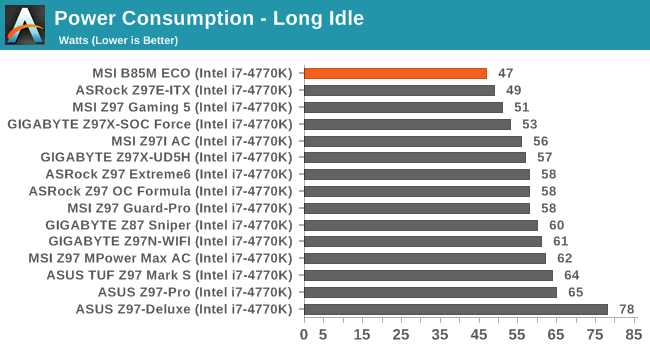
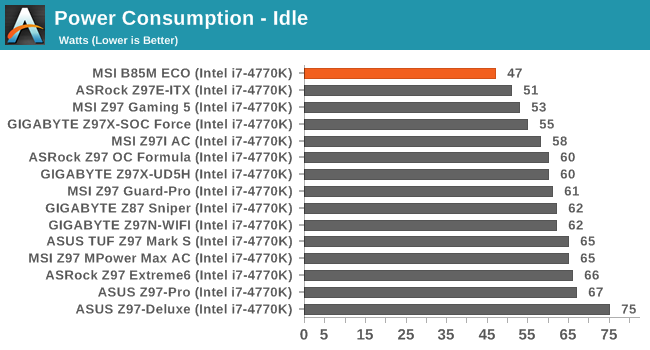
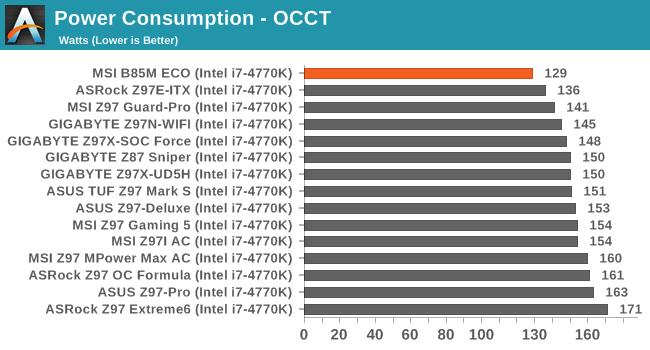
As mentioned previously in the review, when we set the B85M ECO up in the same test bed as our other Haswell-capable motherboards, it goes straight to the top of the list in long idle, idle and load power consumption.
For our 500W Platinum results on the B85M ECO, please refer back to the second page ‘Doing the Math on ECO’. For reference, with the i7-4770K on that power supply, we achieved 40W at long idle and 104W at peak loading.
Windows 7 POST Time
Different motherboards have different POST sequences before an operating system is initialized. A lot of this is dependent on the board itself, and POST boot time is determined by the controllers on board (and the sequence of how those extras are organized). As part of our testing, we look at the POST Boot Time using a stopwatch. This is the time from pressing the ON button on the computer to when Windows 7 starts loading. (We discount Windows loading as it is highly variable given Windows specific features.)
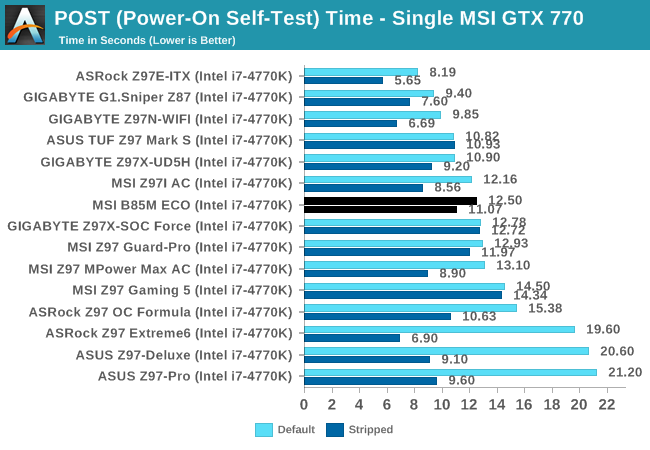
For a system that is heavily stripped, 12.5 seconds might seem like a long POST time. Bear in mind that that B85 is not particularly a platform for POST optimization, compared to the high average selling price market such as the OC Certified and Gaming ranges.
Rightmark Audio Analyzer 6.2.5
Rightmark:AA indicates how well the sound system is built and isolated from electrical interference (either internally or externally). For this test we connect the Line Out to the Line In using a short six inch 3.5mm to 3.5mm high-quality jack, turn the OS speaker volume to 100%, and run the Rightmark default test suite at 192 kHz, 24-bit. The OS is tuned to 192 kHz/24-bit input and output, and the Line-In volume is adjusted until we have the best RMAA value in the mini-pretest. We look specifically at the Dynamic Range of the audio codec used on board, as well as the Total Harmonic Distortion + Noise.

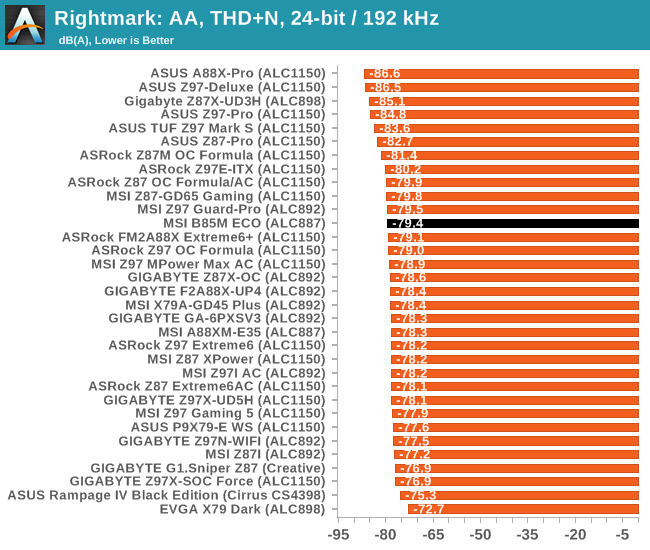
Using an ALC887 audio codec was never going to break any records for audio, but it does as well as can be expected.
USB Backup
For this benchmark, we transfer a set size of files from the SSD to the USB drive using DiskBench, which monitors the time taken to transfer. The files transferred are a 1.52 GB set of 2867 files across 320 folders – 95% of these files are small typical website files, and the rest (90% of the size) are small 30 second HD videos. In an update to pre-Z87 testing, we also run MaxCPU to load up one of the threads during the test which improves general performance up to 15% by causing all the internal pathways to run at full speed.

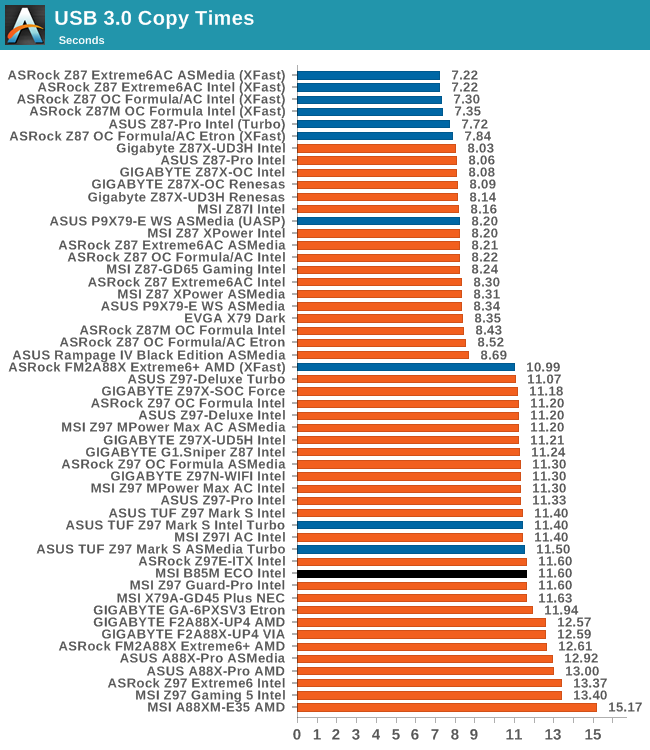
DPC Latency
Deferred Procedure Call latency is a way in which Windows handles interrupt servicing. In order to wait for a processor to acknowledge the request, the system will queue all interrupt requests by priority. Critical interrupts will be handled as soon as possible, whereas lesser priority requests such as audio will be further down the line. If the audio device requires data, it will have to wait until the request is processed before the buffer is filled.
If the device drivers of higher priority components in a system are poorly implemented, this can cause delays in request scheduling and process time. This can lead to an empty audio buffer and characteristic audible pauses, pops and clicks. The DPC latency checker measures how much time is taken processing DPCs from driver invocation. The lower the value will result in better audio transfer at smaller buffer sizes. Results are measured in microseconds.
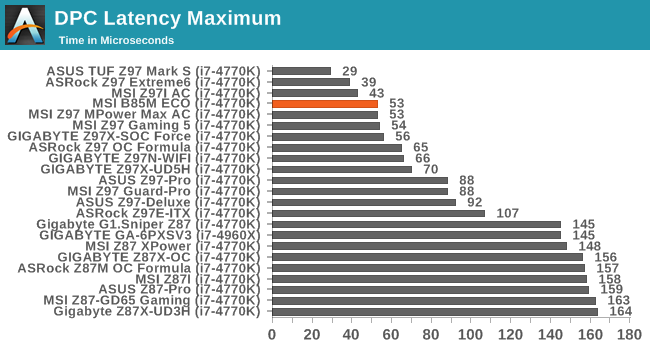
For whatever reason, I had in the back of my mind that an ECO-oriented board would not be that good in DPC Latency. I was greatly surprised when it achieved just over 50 microseconds and into the top part of our result list.










40 Comments
View All Comments
simonpschmitt - Wednesday, November 26, 2014 - link
I just found the board online for 68€ witch means one would break even after 2.2 Years.miksmi - Wednesday, November 26, 2014 - link
For servers, I moved to the mini-ITX form factor and am interested in an ECO version. I keep servers 8-10 years.hojnikb - Wednesday, November 26, 2014 - link
For office (and other non demanding uses) wouldn't it make more sense to go j1900 route rather than eco 1150 + celeron/pentium/i3 cpu ?It will use way less power than 1150 + fanless by default (even more power savings).
Ian Cutress - Wednesday, November 26, 2014 - link
For most office work, you're probably right. But a socketed platform does offer a potential upgrade path if the dynamics of the work change to something more computationally intensive. Also going down the LGA1150 route offers faster response times, which some businesses might argue is important when continuously dealing with emails and so on. It really depends on the scenario.Folterknecht - Wednesday, November 26, 2014 - link
"One of the points in the review was the inability to select a lower CPU voltage. Both voltage and frequency have a role in total system power consumption, but when full performance is still needed, voltage is the only variable left to modify. I posed this question to MSI, and received the following response:“We actually did try to do some testing with lower CPU voltage settings. The reason why we didn’t include it into the current BIOS is because we think Intel’s current FIVR architecture puts too many limits inside their design and we [would] rather use Intel’s integrated power saving features like C-State (Up to C7) and also SVID power. But it’s still a good suggestion that we can request our R&D to do more testing and check if we can fine tune better settings to enhance the power saving ability.”"
Lazy excuse in my book, considering that its still possible to undervolt current generation Intel CPUs quite a bit, at least when it comes to load voltage susually something between 0.1 - 0.2 V. As a MB manufacturer I can imagine that it would even be possible to play around with everything between idle and full load voltage, something a normal user cant do.
So instead of waisting their time on hot marketing air, develop something along the lines of auto-OC software or as an option in BIOS, but instead of overclocking let it undervolt the CPU automatically until it fails. But please no "1-2-3 click ready nonsense" of predefined values, more along the lines of a small stress test, which lowers the voltage by 0.02V or something like that after every sucessfull pass.
The perfect end result would be a bios voltage table (or in software), which fits the cpu installed - we all know the silicon lottery here. In an approach like this, lies much potential for saving energy.
andychow - Wednesday, November 26, 2014 - link
I've worked in the cubicles of many large corporations, and most people just log off their session or lock their screens at the end of the day, they don't turn the computer off. So cost savings would be even more interesting in these scenarios.piasabird - Wednesday, November 26, 2014 - link
So do unused ports and slots use power? Like if you use just 2 ddr3 SLOTS do the empty slots use power? Same with SATA and PCIE? So if the case is so why not use a MITX motherboard?piasabird - Wednesday, November 26, 2014 - link
You cant just look at the cost to run the motherboard. What about an eco friendly Monitor? Then there is the heat that is created to use the motherboard. During the summer or in say a server room something is cooling off the hot air.just4U - Wednesday, November 26, 2014 - link
Hi Ian,I hadn't really noticed that Anand wasn't reviewing business class motherboards. I picked up a H97 GAMING 3 MSI board for my wife a few weeks back.. certainly doesn't look like a business board.. but it does come with all the software. Maybe you will get a chance to review that one in coming months..
Anyway, on this one I almost thought it was a Sniper board at first geez.. GREEN.. Waiting to see your matx x99 review.. should be interesting!
Daniel Egger - Wednesday, November 26, 2014 - link
I LOLed when seeing the TÜV Logos. There're only few certifications like GS that follow a normed procedure. Other than that you can basically specify the test procedure and criteria, deliver the products (and a boatload of cash) and they will certify you that your products passed test procedures by the criteria you've specified. Very useful...The important point of information I'm missing here is: What were the tests? What were the passing criteria? Is there any competition which underwent the same certification and if so what were the results?